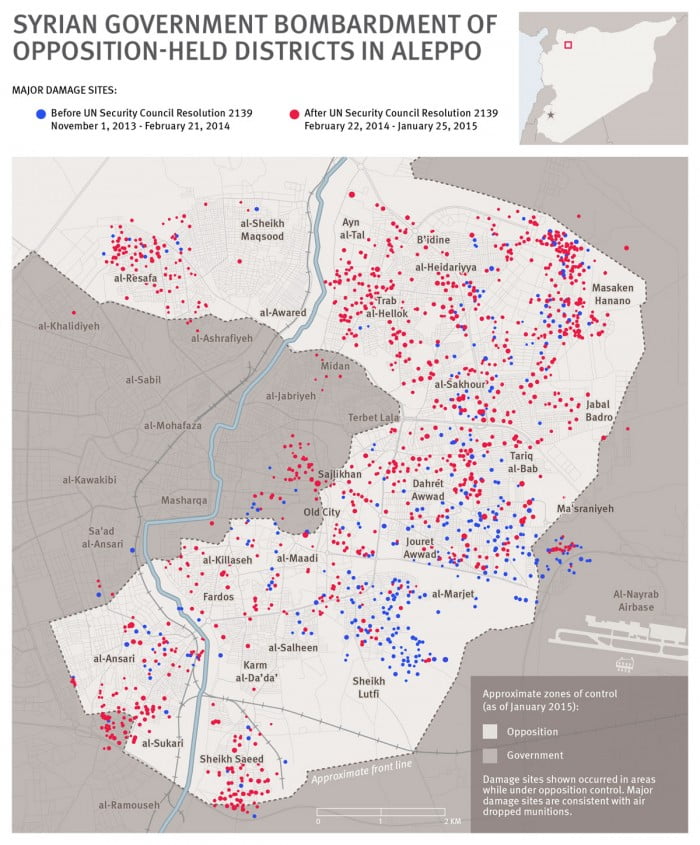

Today’s map comes from Human Rights Watch, which has released new research into the use of barrel bombs in the ongoing conflict in Syria. It may seem like a trivial point to research and argue against just one type of weapon, but the production, deployment, and destruction of the barrel bomb are key to understanding the importance of this specific research. This weapon is inherently indiscriminate and its use in Syria was specifically banned by a UN Security Council resolution a year ago. HRW is now calling on the Security Council not to take new action, but enforce their own previous resolution.
A barrel bomb is essentially an improvised weapon that is designed to “be as deadly as possible,” HRW’s Nadim Houry explained during a press conference at United Nations headquarters. The weapon is cheap to make in practically any domestic production facility, even in war-torn countries. In Syria, HRW says the bombs are likely being made by the Syrian government in abandoned warehouses in previously shelled areas. The barrels are filled with explosives and shrapnel of metal scraps, which makes them all the more dangerous. They are typically released from the air.
According to HRW and the Syrian Network For Human Rights, at least 6,163 civilians have died as a result of barrel bombs. This includes nearly 3,000 women and children. The grim casualty count is only for the last 12 months.
The matching up of video and satellite images to map out barrel bomb sites in Syria done by HRW is not necessarily groundbreaking, but what makes it important is the visual component. It shows that when the barrel bombs are dropped by helicopters, which only the Syrian government owns, civilian areas which include hospitals, schools, mosques, and markets are being hit in addition to rebel locations or often in areas where there are “no discernible military targets,” as stated in a press release. The HRW maps show that the attacks are indiscriminate and in direct violation of UN Security Council Resolution 2139 issued on February 22, 2014 which called for the end of indiscriminate attacks using barrel bombs in populated areas.
The tone of the press conference indicated that HRW is well aware of the political realities of the current Security Council with regards to Russia and China’s opposition to many Syria-related resolutions. However, Resolution 2139 was passed by the Security Council in one of its rare moments of clarity to protect civilians in an increasingly complicated and bloody conflict.
The message to the Security Council as a unit is a simple one: keep your word, enforce 2139 which you passed unanimously. However, Houry calling on “western and emerging powers…[to] increase the pressure on Russia and China to stop blocking international action to curb the Syrian government’s deadly crimes” has proven to be more complicated the last three years.
HRW announced they would be presenting the research to the Russian delegation to the UN yesterday and that the country has been receptive to holding meetings and discussing the issues. The same could not be said for the Chinese, however the delegation is not known for its transparency and open doors in any situation let alone questions on Syria. If Resolution 2139 can be enforced, it will not end the conflict completely but it could be one step toward protecting innocent citizens caught in the middle of ISIS, Assad, and assorted rebel groups. One way to help curb the use of barrel bombs use could be by putting limits on helicopter fuel and spare parts that Syria can access from the outside.
Of course, all this is up to the Security Council’s will. The next meeting on Resolution 2139 will be held February 26, 2015.
